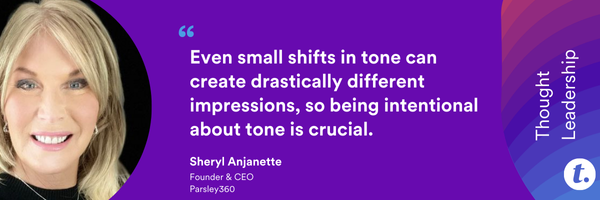
Have you ever said something that was perfectly clear in your mind, only to have it misunderstood—or worse, taken offensively? Often, the culprit isn’t the words themselves but how they were delivered. Tone and inflection can completely change the emotional impact of a message, influencing whether it is received as supportive, neutral, or dismissive.
For HR professionals, tone and inflection are vital tools, especially when navigating high-stakes conversations like delivering feedback, mediating conflicts, or addressing sensitive issues. In this article, we’ll explore how tone and inflection shape communication, common pitfalls to avoid, and strategies to master this essential skill.

The Power of Tone
Tone is the emotional undercurrent of what we say, and it sets the stage for how our words will be received. Think of tone as the music behind the lyrics: it carries emotion, intent, and meaning beyond the literal words.
Examples of How Tone Changes Meaning:
- “Can I talk to you for a minute?”
- Calm and approachable tone: Suggests collaboration or concern.
- Harsh or impatient tone: Feels accusatory or critical.
- “Great job on that project.”
- Genuine tone: Builds trust and morale.
- Sarcastic tone: Undermines credibility and damages relationships.
Even small shifts in tone can create drastically different impressions, so being intentional about tone is crucial.
The Role of Inflection
Inflection refers to the pitch and emphasis in your voice, which can change the meaning of a sentence entirely. Consider this simple phrase: “I didn’t say she stole the money.”
By emphasizing a different word each time, the sentence’s meaning changes:
- I didn’t say she stole the money (someone else did).
- I didn’t say she stole the money (but I implied it).
- I didn’t say she stole the money (someone else did).
Inflection provides clarity and nuance, ensuring your audience understands your intent.
“Inflection provides clarity and nuance,
ensuring your audience understands your intent.”
Common Tone and Inflection Pitfalls
- Unintended Monotone Delivery:
Speaking in a monotone voice can make you seem uninterested or disengaged, even if your words are meaningful. - Inconsistent Messaging:
When tone and inflection don’t align with your words, the audience may feel confused or mistrustful. - Unconscious Habits:
Some people default to a harsh or sarcastic tone without realizing it, which can erode trust over time. - Overuse of Emphasis:
Overly dramatic inflection can come across as insincere or condescending.

Practical Tips for HR Professionals
- Be Intentional About Tone:
Before having a conversation, think about the emotion you want to convey—support, urgency, empathy—and ensure your tone matches your intent. - Record Yourself:
Practicing aloud or recording key messages can help you identify unintended tones or inflections. - Adapt to Your Audience:
Pay attention to how your audience reacts. If they seem disengaged or defensive, consider softening your tone or adjusting your pace. - Practice Active Listening:
Listening to others’ tones and inflections can help you adjust your responses in real-time.
The Role of Technology in Tone and Inflection
While tone and inflection are inherently human traits, AI-powered tools are making remarkable strides in supporting better communication. Today, you can find AI coaching apps that engage users through natural tone and inflection, creating an empathetic and human-like experience. By combining thoughtful word choice with deep listening and imaginative responses, it aims to leave users with the sense of being seen, heard, and understood, aligning with the goal of every meaningful interaction.
These tools go beyond simply analyzing language. They allow individuals to:
- Refine Their Tone: Practice delivering sensitive messages with the appropriate tone, such as giving constructive feedback or addressing conflict.
- Simulate Real-World Scenarios: Engage in role-play conversations to develop confidence and emotional intelligence in their delivery.
- Identify Patterns: Receive feedback on tendencies like overly harsh or passive tones, enabling users to course-correct and align their delivery with their intent.
By complementing human skills, AI tools like Parsley360 empower individuals to refine their communication, create stronger connections, and support workplace harmony. They don’t replace the human element of interaction but provide a safe, accessible way to practice and improve.
“Practicing aloud or recording key messages can help
you identify unintended tones or inflections.”
Conclusion
Tone and inflection are the subtle but powerful forces that bring words to life. For HR professionals, mastering these elements can make the difference between resolving a conflict and deepening it—or between inspiring a team and leaving them feeling demotivated.
As you reflect on your tone and inflection, consider how they complement other communication skills like nonverbal cues and rapport-building. In the final article of this series, we’ll explore the listener’s role in communication and how building rapport can help your messages truly resonate.
Coming up next: The Listener’s Puzzle Piece: Building Rapport and Tailoring Communication

About The Author

Sheryl Anjanette is the founder, CEO, and Chairman of Parsley360, Inc., an AI-driven corporate performance and wellness company holistically solving the issues of retention, burnout, and productivity through emotionally intelligent AI. Sheryl is also the author of The Imposter Lies Within, a keynote speaker on the topics of Imposter Syndrome, Burnout, The Future of Work, and AI, and holds advanced certifications in Human Performance Improvement (HPI), Cognitive Behavioral Neuroscience, and Stress, Anxiety, and Self-Regulation. Check out Sheryl’s TEDx talk, How Empathetic AI Can Change the World.
To learn more about how Parsley is helping to reshape The Future of Work, visit www.parsley360.com.
Other articles to enjoy by Sheryl:
Transform Founder Spotlight, Sheryl Anjanette, Founder & CEO of Parsley360
The Power of Communication: Words Are Just the Beginning
What You’re Saying Without Saying It: The Impact of Nonverbal Cues
Videos with Sheryl:
The Conscience of AI: Ethics, Empathy, and Fair Use in Modern Business
